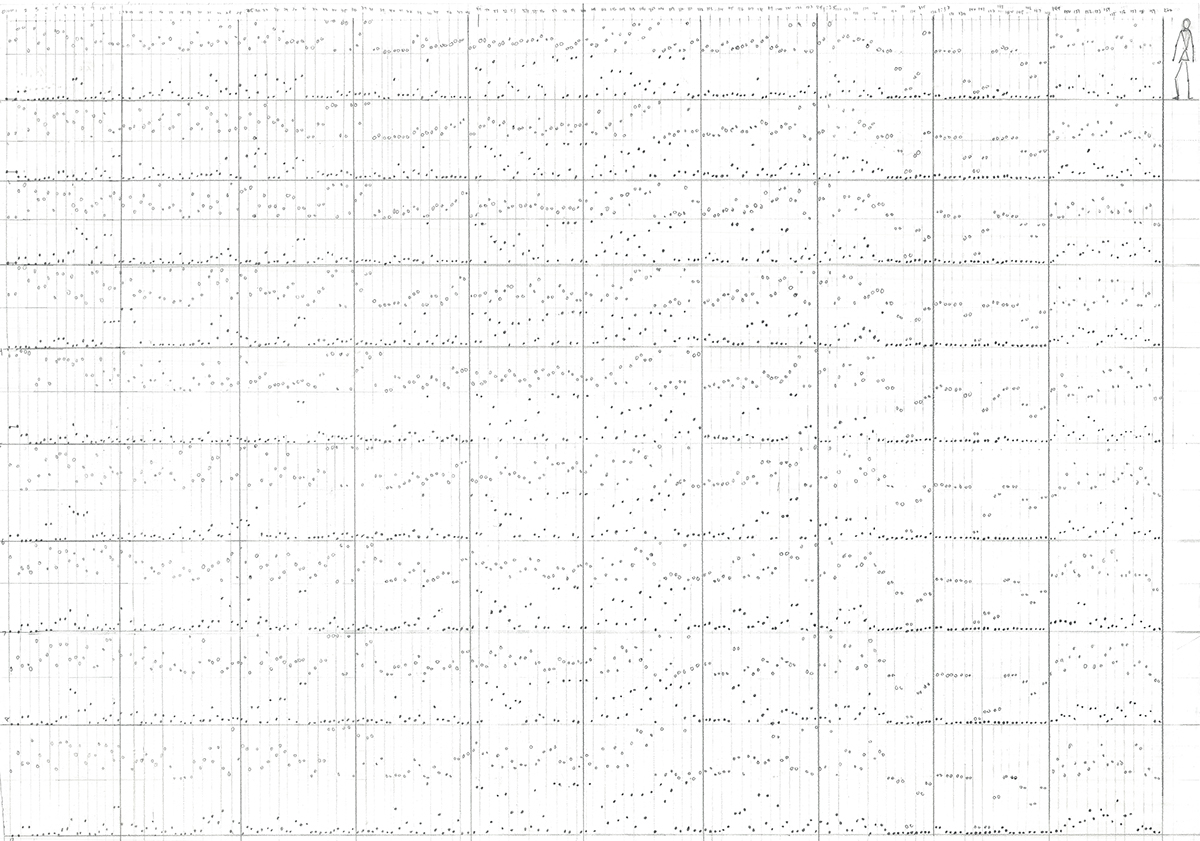
Analytical mapping of vertical displacement of hands and feet used as blueprint of model's design. Each double set of rows shows the coordination in accordance to the datum, the waist. The body on the top right provides scale. The map is measured in seconds, with the scene lasting two minutes long, spanning the map over 120 seconds.

Analytical mapping of vertical displacement of hands and feet used as blueprint of model's design. This map depicts the nine dancers' movements overlaid on top of each other, portraying the mean movement throughout the Sacrifice scene.

Analytical mapping of vertical displacement of hands and feet used as blueprint of model's design. This map depicts the nine dancers' movements overlaid on top of each other, portraying the mean movement throughout the Sacrifice scene. This more specific map shows the movements over time connected linearly to the previous location one second ago and more.
Final model.
Final model.
Final model.
Final model.
Final model.
Final model.
Final model.

Sectional perspective experiential charcoal drawing of interior space connecting to other spaces. 5' x 7'.

Ground floor plan.

section c: north-south (east).

section d: east-west (north).
// House for a Dance
Done for Professor Carl Lostritto
RISD
This project is a developmental process encompassing the procedures and applications of both Dance for a Line and Space for a Dance. This tertiary project incorporates a specialty: the architecture must house a distinct excerpt for Igor Stravinsky’s The Rite of Spring ballet (any choreographic adaptation) or its entirety. The design was to orient around the specific dance routines, steps, rhythm, acoustics, or the score itself, or a combination of such. I chose the Vlasav Nijinsky choreography of The Rite of Spring (1913), aiming especially on the scene involving the sacrificial dance.
I began this process by understanding the dance routines of the excerpt, as its comprehension is a requisite of the design to house the dance, or in this case, its sacrificial dance. I mapped the vertical movements of the hands and feet of the individual dancers, plotting their locations across a horizontal datum, established as the waistline. The locations, vertical displacements of the bodies’ extremities (hands and feet) relative to that datum became the fulcrum around which design, analysis, and execution operated.
The element of the Nijinsky choreography was the focus on the Sacrifice. By documenting these movements of extremities, I translated the rhythmic program of hands, feet, and proximal movement into a controlling of experiential encounter (entrance from road), ambulation (circulation throughout the model) and revelation (return to road). The map displays the dimensional movement of the bodies throughout the dance linearly, which is capable of data extraction needed for experiential observation of the dancers. By analyzing how high a hand reaches or low a foot descends in time and space, I revolved the model and surveillance the former contains around this analysis.
This specific method of reading the dance is made manifest in the offset volumes and columnar limitation of view. Ambulation occurring around the principal volume, the center stage on which the dance takes place, and upon the secondary and tertiary volumes, is divided into two paths, both starting from opposite ends of the road and ending where the other path begins.
To specialize this model to The Rite of Spring, particularly the Sacrifice scene, I emphasized the key times during the dance when the hands and feet move and displace the greatest. Occurring either in intervals or instantaneously, these specifications, deemed “keyframes” break the repetition of the columns but not wholly, and the audience is allowed more vision of the dance due to the angling of the external set of columns. Otherwise, at the walking pace of the viewers, the double columns integration offers fleeting visions of the dance, as if the dancers were frozen in time inside each space left open by the complementary columnar systems. It is as if looking at an Eadweard Muybridge motion-picture projections (frozen frames of a scene in motion) at a much faster pace but not fast enough to seem believable or “real”. In order to help guide the audience to these keyframes of the dance, already fragmented during circulation, the striations formalized as linear elements upon the volumes’ floors direct attention to the center of the dance, the centroid of the platform, the woman being sacrificed; the crux of the totality.
This synchronization of dance and experience is portrayed in the specific limitation of view, the polar ambulation paths, and the interjection and emphasis of keyframes of the Sacrifice scene in Nijinsky’s choreography The Rite of Spring.





